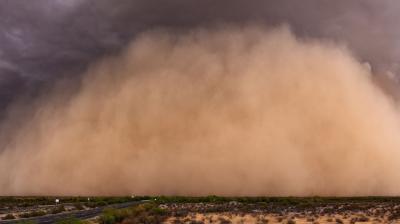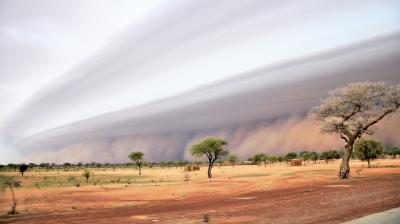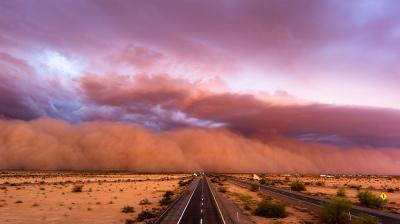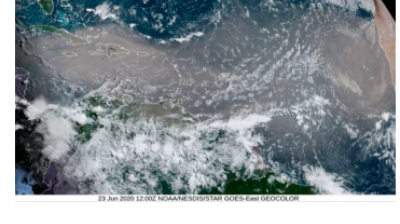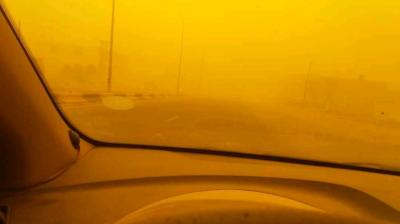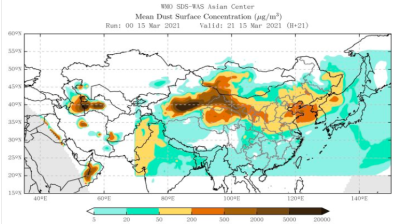
Sand and dust storms
Sand and dust storms (SDS) occur when strong winds lift sand and dust from dry soils into the atmosphere, transporting particles over vast distances. They impact climate, weather, and ecosystems and harm human health, agriculture, transportation, and solar energy. At the same time, they also supply nutrients to ocean ecosystems.
Overview
The most significant dust sources globally are concentrated in arid and semi-arid regions, particularly major deserts such as the Sahara in Africa, the Gobi in Asia, and the Arabian Desert in the Middle East.
Sand and dust storm activity varies widely depending on geographical location, climate conditions, and local environmental factors. They originate from natural sources like deserts, dry lake beds, and coastal regions with loose sediment. Human activities exacerbate the problem through construction, agriculture, and poor land management practices that strip vegetation and expose soil to wind erosion. Climate change amplifies the occurrence of sand and dust storms by altering weather patterns and reducing vegetation cover.
Dust is a major component of atmospheric aerosols, which are essential climate variables characterizing the Earth's climate. Dust particles also significantly impact weather due to feedback processes related to atmospheric dynamics, cloud formation, and precipitation.
Impact
Sand and dust storms are environmental and weather-related phenomena that affect nearly all countries across the world. Sand and dust storms often begin in dry, desert areas—but their effects can reach far beyond the source. Powerful winds can lift tiny dust particles high into the atmosphere and carry them thousands of kilometers across continents and oceans.
In countries within or near desert dust sources, sand and dust storms can seriously harm livestock, agriculture, and human health. Strong storms may also close roads and airports due to poor visibility and damaged infrastructure. They can also disrupt solar energy production.
In distant regions, dust in the air can reduce air quality, block sunlight, or disrupt transportation. Saharan dust storms can be transported thousands of kilometers across the ocean, impacting daily life in the Caribbean. An intrusion of Saharan dust into the European Alps in March 2022 contributed to record glacier loss that year. However, transported dust can also bring benefits. Nutrients in the dust help fertilize marine and land ecosystems, benefiting agriculture and fisheries.
Recognizing the negative impacts of sand and dust storms worldwide, the United Nations General Assembly established the United Nations Coalition on Combating Sand and Dust Storms in 2017 (A/RES/72/225). WMO plays a central role in the Coalition by leading efforts in monitoring, forecasting, and early warning.
The importance of a coordinated response has been reaffirmed in recent General Assembly resolutions. In 2023, the General Assembly called for a high-level meeting to strengthen international cooperation (A/RES/78/158). It also declared 2025–2034 as the United Nations Decade on Combating Sand and Dust Storms, promoting long-term solutions and joint action (A/RES/78/314). To raise awareness, 12 July was proclaimed as the International Day of Combating Sand and Dust Storms (A/RES/77/294)—a moment each year to spotlight the issue and encourage global commitment.
WMO's response
WMO’s Sand and Dust Storm Warning Advisory and Assessment System was set up in 2007. It seeks to strengthen operational forecasting and warning services for various regions of the world in a globally coordinated manner to reduce the impacts on the environment, health, and economies. This collaborative international partnership of research, operational, and user communities facilitates the transfer of technology from research to serve society.
There are four regional centres which provide forecasts for Northern Africa, the Middle East, Europe, Asia, the Americas, and the Gulf Cooperation Council.
To provide regular scientific information, WMO produces an annual Airborne Dust Bulletin .
WMO’s Sand and Dust Storm Warning Advisory and Assessment System also contributes to the science that underpins the United Nations Coalition for Combating Sand and Dust Storms, leading the activities connected with forecasting and early warnings. It is an essential part of the international Early Warnings for All initiative to ensure that everyone in the world is covered by early warnings of hazardous events.






